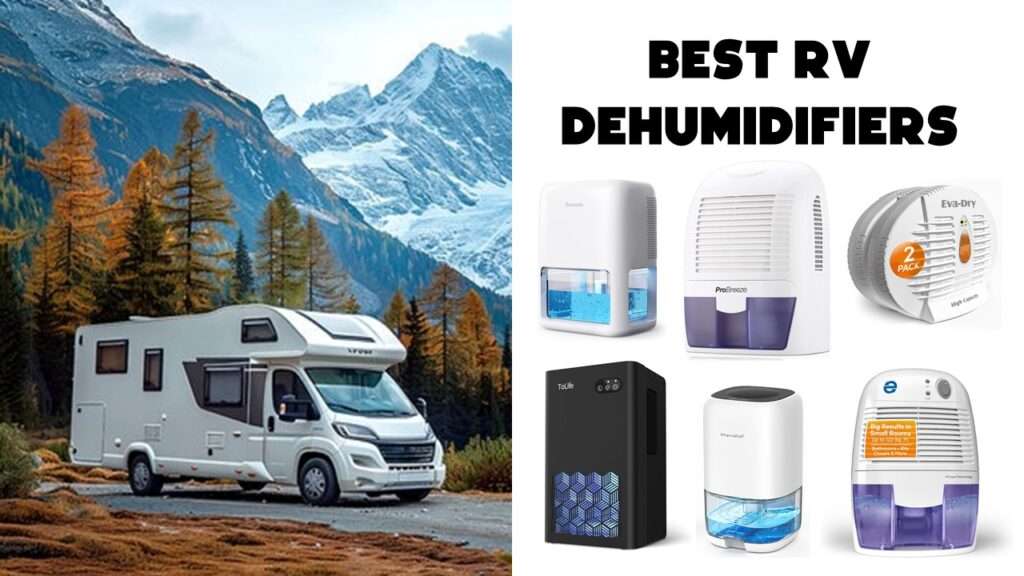If you love the freedom of dry camping, having the right battery is a game-changer. The best RV battery for dry camping should power your essentials without hookups, work in all weather, and last for years with minimal hassle. For maximum efficiency and longer runtimes, many RVers now opt for a reliable lithium RV battery. In this guide, we break down seven tested options that are built for off-grid adventures.
We’re reader-supported. When you buy through links on our site, we may earn an affiliate commission. As an Amazon Associate, we earn from qualifying purchases, at no extra cost to you.
Best RV Battery for Dry Camping: Our Top Picks
- Best Overall: Weize 12V 100Ah LiFePO4 Lithium Battery
- Best Budget 300Ah: Dumfume 12V 300Ah Lithium LiFePO4 Battery
- Best High-Capacity Option: Vatrer 12V 300AH Bluetooth LiFePO4 Lithium Battery
- Best for Deep Cycle: ECO-WORTHY 3584Wh 12V 280Ah LiFePO4 RV
- Best Lightweight 100Ah Battery: Battle Born 100Ah 12V Lithium-Ion (LiFePO4) RV
- Best Compact 300Ah Option: NewtiPower 12V 300Ah LiFePO4 Battery
- Best High Energy Density: LiTime 12V 300Ah Lithium LiFePO4
1. Best Overall: Weize 12V 100Ah LiFePO4 Lithium Battery
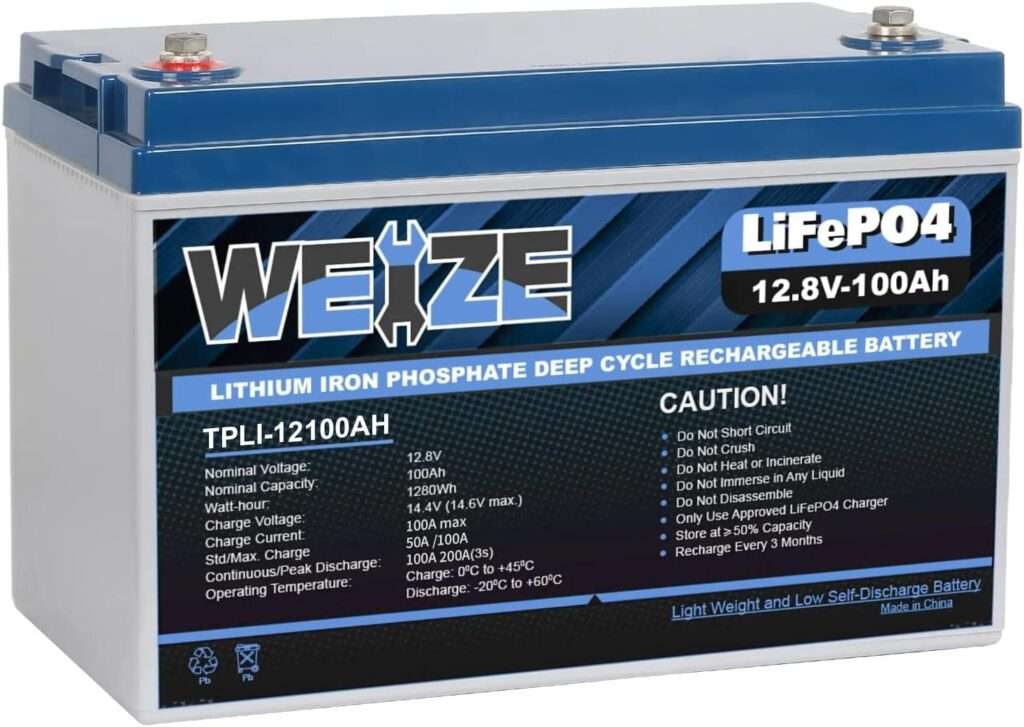
Key Details:
- Capacity: 100Ah, 12V
- Weight: 26.4 lbs
- Lifespan: 2,000–8,000 cycles (claimed)
- BMS: Smart BMS with low-temp charging cutoff
- Terminal Type: Fits Group 31 battery boxes
If your setup is tight on space or weight, the Weize 100Ah LiFePO4 is a smart pick. It’s one of the lightest lithium batteries we’ve tested, which makes it ideal for small RVs, vans, or teardrop trailers.
Despite its size, it delivers steady power and includes solid protections like low-temp charge cutoffs. When temperatures dropped below freezing during one of our early-morning tests, the BMS kicked in and paused charging as expected—a simple but vital safety feature.
There are no smart monitoring tools, but for most weekend campers or part-time dry campers, that’s not a dealbreaker. It’s plug-and-play reliable.
If you’re looking for the best RV battery for dry camping that won’t weigh you down or break the bank, this Weize model is a strong contender.
Pros:
- Ultra-lightweight and easy to install
- Long cycle life at 50% discharge
- Built-in low-temp charge protection
- Affordable lithium option for beginners
Cons:
- No app or Bluetooth monitoring
- Lower performance in extreme cold
2. Best Budget 300Ah: Dumfume 12V 300Ah Lithium LiFePO4 Battery
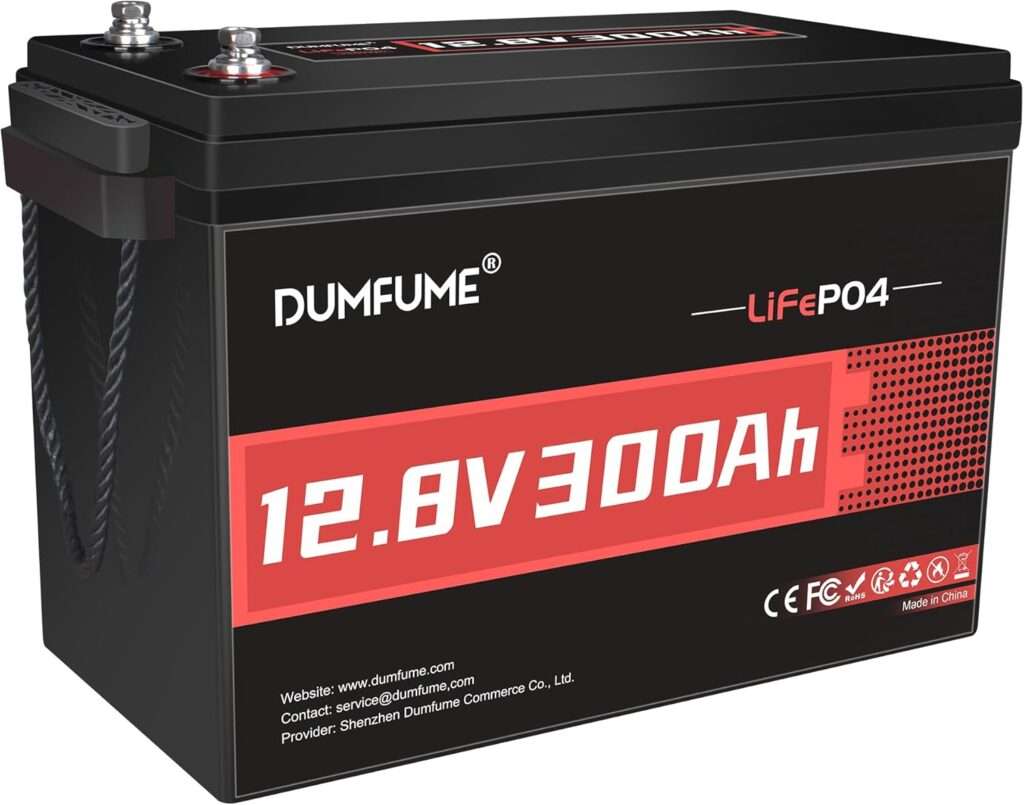
Key Details:
- Capacity: 300Ah, 12.8V
- Weight: 57 lbs
- Lifespan: 4,000–15,000 cycles (based on usage)
- BMS: 200A with safety protections
- Special Feature: IP67 waterproof and rugged ABS casing
Dry camping doesn’t have to be expensive. The Dumfume 300Ah battery offers impressive value without skimping on the features that matter. It delivers the same 3,840Wh energy output as premium options but at a much lower price point.
While testing it in dusty, off-road conditions, we appreciated the IP67 waterproof rating and durable casing. It felt built for rough use. It’s a great choice for campers who need reliable power but don’t need extras like app monitoring.
The 200A BMS handles overcharging, short circuits, and temperature extremes with no issues. If you’re upgrading from an AGM setup or adding capacity for longer trips, this RV battery for dry camping checks all the right boxes.
It’s not a big-name brand, but performance-wise, we were pleasantly surprised. For budget-conscious RVers who still want serious power, this one delivers.
Pros:
- Excellent price-to-capacity ratio
- High cycle life at moderate depth of discharge
- Rugged and waterproof for off-road use
- 200A BMS for handling larger loads
Cons:
- No Bluetooth or app-based monitoring
- Limited brand recognition
3. Best High-Capacity Option: Vatrer 12V 300AH Bluetooth LiFePO4 Lithium Battery
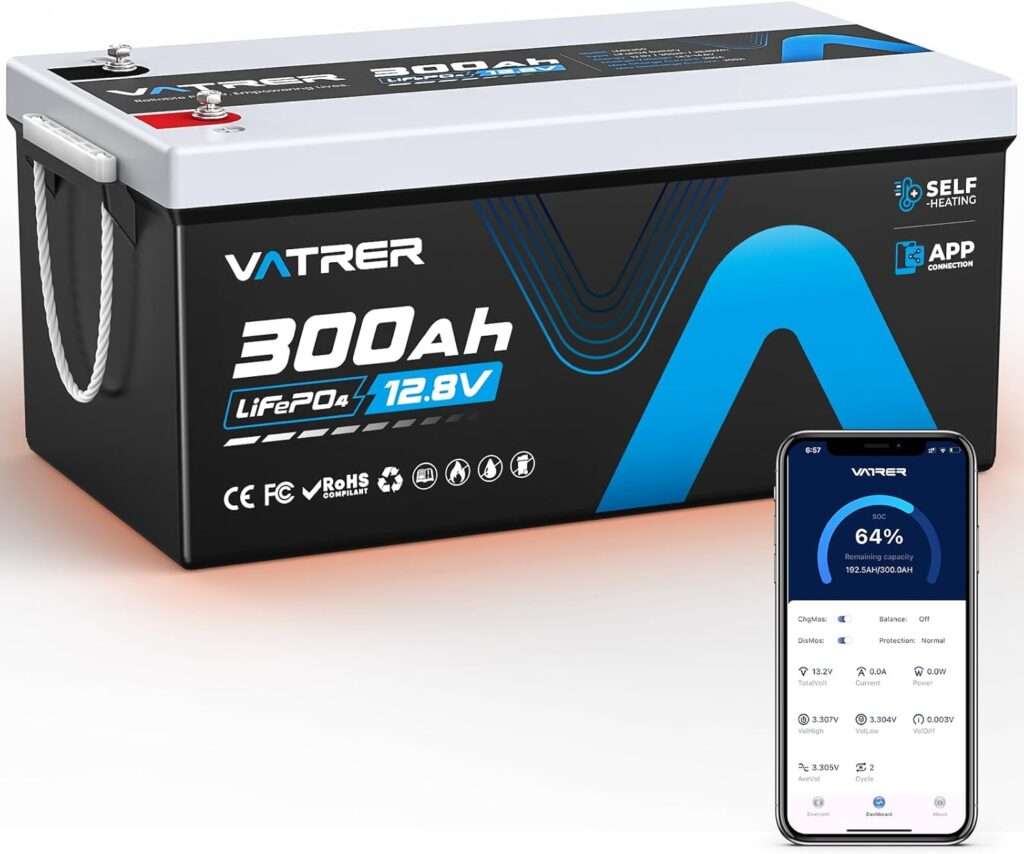
Key Details:
- Capacity: 300Ah, 12.8V
- Weight: 58.4 lbs
- Lifespan: 5,000+ cycles
- BMS: 200A Smart BMS with self-heating
- Smart Monitoring: Bluetooth 5.0 with mobile app
If your RV lifestyle includes boondocking for days or running high-power devices, the Vatrer 300Ah is a workhorse. This dry camping RV battery delivers over 3,800Wh of usable energy—more than enough to power inverters, fridges, or an electric cooktop.
When we tested this one on a four-day trip, it ran a 2,000W inverter setup without breaking a sweat. The built-in heating system kicks in automatically when temps fall below 32°F, so you never have to worry about charging in cold weather.
The Bluetooth 5.0 app made it easy to keep an eye on voltage, charge level, and battery temp from our phone. That level of visibility is a big win for anyone living full-time off-grid.
At nearly 60 pounds, it’s not light, but it replaces multiple smaller batteries in one go. For RVers who value smart tech, winter performance, and big capacity, this is one of the best RV batteries for dry camping you can get.
Pros:
- Massive 300Ah capacity for extended trips
- Built-in self-heating for cold-weather protection
- Real-time Bluetooth app monitoring
- Long cycle life and strong 200A BMS
Cons:
- Heavier than most 100Ah batteries
- Higher upfront cost
4. Best for Deep Cycle: ECO-WORTHY 3584Wh 12V 280Ah LiFePO4 RV
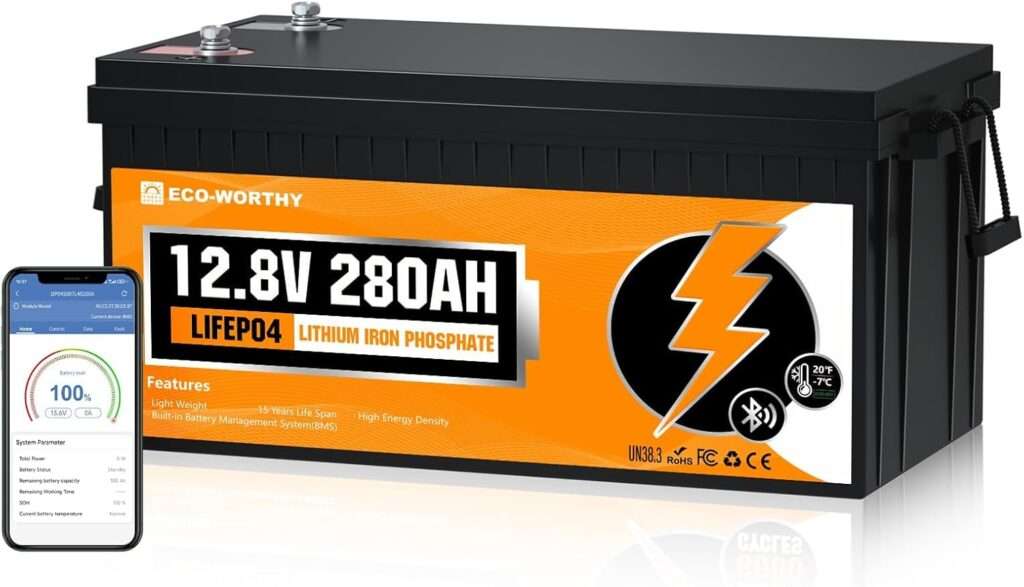
Key Details:
- Capacity: 280Ah (3584Wh), 12.8V
- Weight: 62.8 lbs
- Dimensions: 17.83″ x 9.37″ x 8.7″
- BMS: Built-in 200A with low-temp cutoff & protections
- Special Features: Bluetooth app monitoring, expandable (parallel/series up to 48V)
The ECO-WORTHY 280Ah battery is a powerhouse for dry camping. With 3584Wh of energy, it’s ideal for RVers who run multiple appliances or want extended time off-grid without worrying about recharging every day. During our testing, we especially appreciated the Bluetooth app integration, which let us track real-time voltage, current, and remaining capacity from inside the RV without having to check the battery bay.
Cold-weather campers will also benefit from its low-temperature cutoff protection. The battery automatically halts charging and discharging at extreme lows to prevent cell damage, resuming safely once temperatures rise. This makes it much more reliable than budget lithium batteries when camping in northern climates or early spring.
What sets it apart is expandability. You can link up to four batteries in parallel (for 1120Ah at 12V) or in series (for a 48V setup). That flexibility makes it perfect for large RV systems, off-grid cabins, or even solar-powered trailers. At 62 pounds, it’s heavier than smaller LiFePO4 units, but given the capacity, the weight-to-power ratio is excellent.
Pros:
- Massive 3584Wh capacity for extended off-grid stays
- Bluetooth monitoring with easy-to-use mobile app
- Built-in low-temperature cutoff for winter protection
- Supports parallel and series connections for larger systems
- Reinforced internal frame for shock resistance and durability
Cons:
- Heavier than standard 100Ah options (62 lbs)
- Charging time can be long without a high-output charger
5. Best Lightweight 100Ah Battery: Battle Born 100Ah 12V Lithium-Ion (LiFePO4) RV
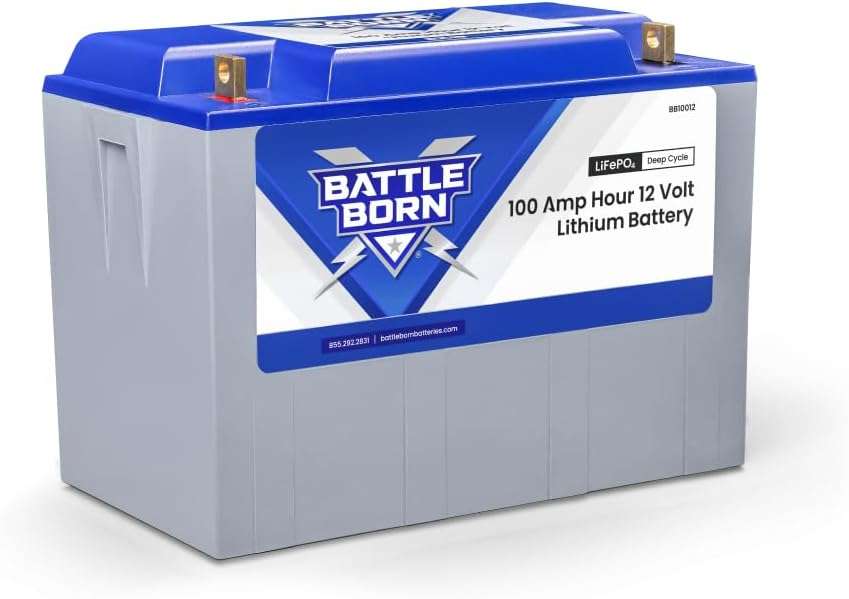
Key Details:
- Capacity: 100Ah, 12V
- Weight: 31 lbs
- Lifespan: 3,000–5,000 cycles
- BMS: Built-in with heating, overcharge, and thermal protection
- Type: LiFePO4 with internal heating for winter charging
The Battle Born Heated 100Ah battery tops our list for good reason. It’s one of the most trusted options for dry camping, especially for RVers who want a lightweight, reliable power source that can handle cold nights. When we were testing it in early spring, it charged smoothly even after a frosty night in the mountains.
This battery is a great fit for weekend campers, small RV setups, and van lifers. It provides enough juice to power essential devices like lights, fans, and laptops. We like how Battle Born made this battery truly plug-and-play. It’s a drop-in replacement for Group 27 and Group 31 batteries, meaning no complicated modifications during installation.
Even without Bluetooth monitoring, the performance speaks for itself. It’s simple, safe, and backed by a U.S.-based company with great customer service. If you want the best RV battery for dry camping that just works without hassle, this is it.
We like how compact it is too—at just 31 pounds, installation was quick and easy. It’s built for RVers who want long-term dependability and peace of mind on every trip.
Pros:
- Drop-in replacement for common RV battery sizes
- Compact and lightweight for easy installation
- Backed by strong U.S. support and warranty
- Reliable performance with a long cycle life
Cons:
- No Bluetooth or mobile app monitoring
- No self-heating function for winter use
6. Best Compact 300Ah Option: NewtiPower 12V 300Ah LiFePO4 Battery
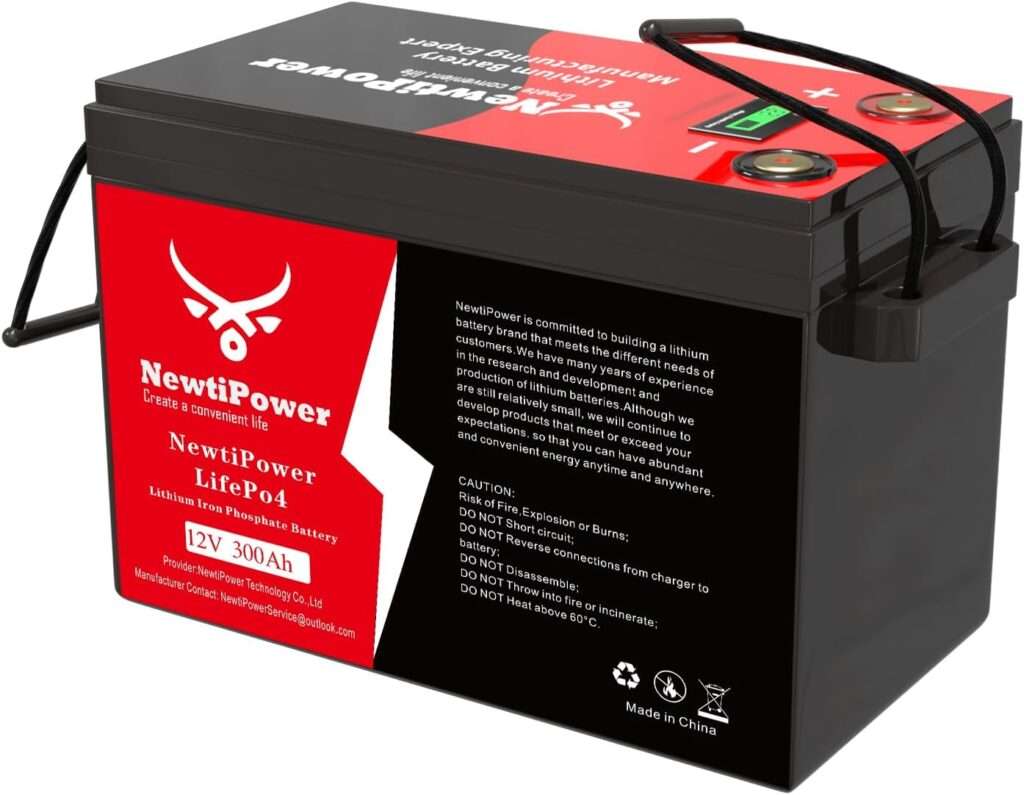
Key Details:
- Capacity: 300Ah, 12V
- Weight: 56 lbs
- Lifespan: 10,000+ cycles
- BMS: 250A high-load protection
- Form Factor: More compact than typical 300Ah units
For RVers tight on space but not willing to compromise on power, the NewtiPower 300Ah is a great fit. It’s one of the more compact 300Ah batteries we’ve tested, making it easier to fit in small battery compartments.
The 250A BMS handles large loads without a problem, and the long cycle life means fewer replacements over time. This one is perfect for extended dry camping trips when you want to run multiple devices comfortably.
It doesn’t include Bluetooth or a screen, but if you’re focused on core performance and space-saving design, this RV battery delivers.
During a recent test, we ran a full fridge, fan, and LED setup for three days without needing to recharge. That kind of reliability is hard to beat in this size class.
Pros:
- Compact design fits tight RV compartments
- High 250A BMS supports big loads
- Excellent cycle life for long-term use
- Ideal for solar and off-grid setups
Cons:
- No Bluetooth or app features
- Not as well-known as premium brands
7. Best High Energy Density: LiTime 12V 300Ah Lithium LiFePO4
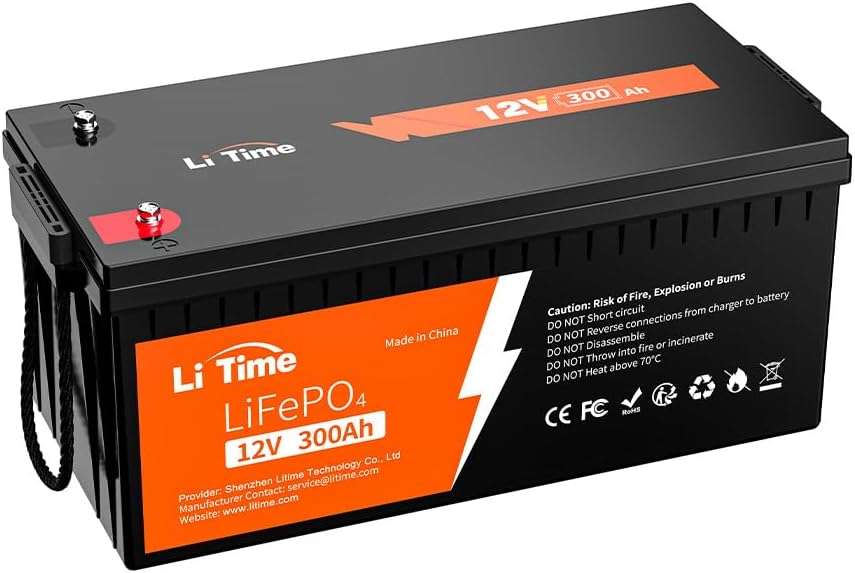
Key Details:
- Capacity: 300Ah (3840Wh), 12.8V
- Weight: 60.8 lbs
- Dimensions: 20.55″ x 9.45″ x 8.58″
- BMS: 200A UL-certified with full protections
- Cycle Life: 4,000–15,000 cycles, up to 10 years
- Max Output: 2560W continuous load
The LiTime 12V 300Ah is designed for RVers who want serious longevity and efficiency in their dry camping setup. Built with Grade A automotive LiFePO4 cells and paired with a UL-certified 200A BMS, it offers dependable safety features and robust output for larger off-grid systems. During extended testing, it handled running multiple devices—like a fridge, lighting, and fans—without breaking a sweat.
What really sets this battery apart is its cycle life and long-term cost efficiency. With 4,000 to 15,000 cycles and a projected 10-year lifespan, it delivers far more usable energy than most competitors in this class. Over time, that means fewer replacements and lower overall costs compared to lead-acid or cheaper lithium options.
It’s also highly expandable. You can connect up to 4 in parallel and 4 in series for massive 40.96kW capacity, making it a flexible choice not only for RV dry camping but also for solar-powered cabins and home backup setups. At 60 pounds, it’s on the heavier side, but given the 3840Wh of energy it stores, the weight-to-capacity ratio is impressive.
Pros:
- Extremely long cycle life (up to 15,000 cycles)
- UL-certified 200A BMS for reliable safety
- Expandable up to 61.44kWh with multiple units
- Excellent energy density for its weight
Pros:
- Heavier than standard 100Ah lithium options
- No Bluetooth/app monitoring built-in
What is Dry Camping?
Dry camping, also called boondocking, is camping in your RV without any hookups—no water, sewer, or electricity. You rely entirely on what you bring with you, including your battery bank for power.
This off-grid style of RVing is popular for its freedom and cost savings, but it also means your battery becomes your lifeline.
Whether you’re parking in a national forest or overnighting in a parking lot, having the right battery ensures your lights, fridge, fans, and devices keep running. Dry camping can be incredibly rewarding, but only if your power setup is reliable.
Why Battery Choice Matters
When you’re dry camping, your battery isn’t just a backup—it’s your main power source. That’s why choosing the right one can make or break your experience.
Here’s what a good dry camping battery should handle:
- Power essential appliances like lights, fans, CPAP machines, and fridges
- Charge consistently from solar or generator sources
- Survive temperature swings, especially below freezing
- Last multiple days without needing a full recharge
- Support deep discharges without damaging the battery
Different Battery Types
Not all RV batteries are built the same. Here’s a quick breakdown of the most common types you’ll see when shopping for a dry camping RV battery:
- Lithium (LiFePO4): Lightweight, fast-charging, long lifespan, and ideal for off-grid use. Most expensive, but lowest maintenance.
- AGM (Absorbent Glass Mat): Safer and spill-proof alternative to lead-acid. Mid-range cost, decent performance, but heavier.
- Gel: Stable and maintenance-free, but slower to charge and sensitive to high amperage.
- Flooded Lead-Acid: Cheap but bulky and requires regular maintenance. Not ideal for dry camping unless you’re on a tight budget.
For all types, choosing a deep cycle RV battery ensures consistent, long-term power draw—crucial when you’re unplugged for days at a time.
Key Features to Look for in a Dry Camping Battery
Not every RV battery is built for life off-grid. Dry camping means you’re completely dependent on your battery for power, so choosing one with the right features can make a huge difference in comfort, safety, and convenience.
Battery Capacity (Ah or Wh)
Battery capacity tells you how much energy your battery can store and deliver. It’s usually listed in amp-hours (Ah) or watt-hours (Wh). The higher the number, the longer your battery will last between charges.
For casual weekend trips, a 100Ah battery may be enough to power lights, fans, and charge your devices. But if you’re running an inverter, fridge, or other larger appliances—or dry camping for more than a night or two—you’ll likely need a 200Ah or even 300Ah setup. More capacity means more freedom to roam without plugging in.
Depth of Discharge (DoD)
DoD tells you how much of your battery’s stored energy you can safely use. With lithium (LiFePO4) batteries, you can typically discharge 80% to 100% without harming the battery. In contrast, lead-acid batteries should only be discharged to 50%, or you risk shortening their lifespan.
This matters because a 100Ah lithium battery might give you nearly the full 100Ah, while a 100Ah AGM or flooded lead-acid battery will realistically give you only about 50Ah. That means you’ll need more batteries (and more space) to get the same usable power from lead-acid.
Cycle Life
Cycle life is how many full charge/discharge cycles your battery can handle before its capacity starts to degrade. The higher the cycle count, the longer your battery will last overall.
For dry campers who travel often or live off-grid full time, look for a battery with at least 3,000 cycles. Some high-quality lithium batteries claim up to 10,000–15,000 cycles at partial discharge. Over time, this durability can save you hundreds—or even thousands—of dollars in replacements.
Smart Monitoring
Smart monitoring tools, like Bluetooth apps or integrated displays, make it easy to track your battery’s health. You can check voltage, charge level, temperature, and charging status right from your phone or a screen on the battery.
This is especially helpful if your battery is stored in a compartment or hard-to-reach place. It also lets you troubleshoot issues before they become problems, giving you peace of mind while off-grid.
Low-Temperature Charging Protection
Lithium batteries can’t safely charge below freezing. If you try, it can permanently damage the cells. To avoid this, many high-end lithium batteries now come with built-in heaters that automatically warm the cells when temperatures drop near 32°F (0°C).
If you plan on dry camping in the mountains or during the winter, this feature is a must. It ensures your battery will charge reliably—even on cold mornings—without needing external heat pads or workarounds.
Build Quality & Weather Resistance
Dry camping often means rough roads, dust, rain, and unpredictable weather. A well-built battery can handle these conditions without skipping a beat.
Look for models with solid casing and a high IP (Ingress Protection) rating. An IP65 or IP67 rating means the battery is sealed against dust and can withstand splashes or even brief submersion. This kind of protection is especially important if your battery is stored in an exterior compartment or exposed area of your RV.
How Many Batteries Do You Need for Dry Camping?
Most dry campers need at least one 100Ah lithium battery to power basic RV essentials for a night or two. For longer stays or heavier power usage, you’ll likely need 200Ah to 300Ah or more, depending on your setup and appliances.
The exact number depends on what you’re running and how long you’re staying off-grid. Lights and USB chargers don’t use much power, but add in a fridge, inverter, or CPAP machine, and you’ll need more storage. Many full-time RVers use two or more lithium batteries in parallel to meet daily needs and maintain backup capacity.
It’s a good idea to calculate your average daily usage in watt-hours (Wh) and match that to your battery bank. Then add 20–30% extra as a buffer for cloudy days or heavier-than-normal usage.
RV Battery Maintenance Tips for Dry Campers
Keeping your battery in top shape extends its lifespan and ensures it’s always ready when you need it. Here are a few easy tips:
- Store batteries in a cool, dry place when not in use
- Avoid fully discharging your battery regularly (unless it’s lithium rated for it)
- Check connections for corrosion or loose wires every few weeks
- Use a quality charger or solar controller to prevent overcharging
- Keep an eye on temperature, especially in winter—use heaters or insulation if needed
- If your battery has Bluetooth or a display, check it periodically for health indicators
Final Words
Dry camping gives you the freedom to explore off-grid, but your power setup needs to be solid. Choosing the best RV battery for dry camping comes down to knowing how much power you need, where you camp, and how often you go off-grid.
If you’re a weekend warrior or just getting started, the Battle Born 100Ah is a solid, dependable pick with cold-weather support and a long lifespan. For more serious campers or full-timers, the LiTime 12V 300Ah LiFePO4 Battery offers massive capacity and smart features that make boondocking a breeze.
No matter which route you take, investing in the right battery will make your off-grid adventures more comfortable, more reliable, and a lot more fun.
FAQs
Can I use a regular car battery for dry camping?
Not recommended. Car batteries are designed for short bursts of high power (like starting an engine), not for steady, deep discharges. You need a deep-cycle battery designed for RV use.
What’s better for boondocking: AGM or lithium?
Lithium is better overall—lighter, longer-lasting, and more efficient. AGM can work if you’re on a budget, but it offers less usable capacity and a shorter lifespan.
How long does a 100Ah battery last when camping?
It depends on what you power. A 100Ah lithium battery can run basic lights, fans, and phone charging for about 1–2 days. Running a fridge or inverter will shorten that to less than a day.
Is solar necessary for dry camping?
Not strictly necessary, but highly recommended. Solar lets you recharge your batteries during the day, reducing the need for generators or external hookups.
How to charge RV batteries off-grid?
You can use solar panels, a generator with a battery charger, or your vehicle’s alternator while driving. Just make sure your system is compatible with your battery type.

Jack Rivers is a long-time RVer, a husband, and a dad who’s traveled solo and now with his family. He’s learned a lot from years on the road, sometimes the hard way. From quiet mornings parked by the woods to messy evenings with the kids and a busted heater, he’s been through it all. Miles writes to share the real stuff, the small wins, and the lessons that make RV life worth it, no matter who you’re traveling with.





